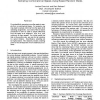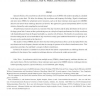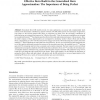1511 search results - page 42 / 303 » On the effectiveness of address-space randomization |
CVPR
2004
IEEE
13 years 11 months ago
2004
IEEE
This paper develops an analytic model for self shadowing and local illumination of rough surfaces. The surface is assumed homogeneous, isotropic, and smooth microscopically, with ...
IJCAI
2003
13 years 9 months ago
2003
For probabilistic reasoning, one often needs to sample from a combinatorial space. For example, one may need to sample uniformly from the space of all satisfying assignments. Can ...
JSS
2010
13 years 6 months ago
2010
Random testing is not only a useful testing technique in itself, but also plays a core role in many other testing methods. Hence, any significant improvement to random testing ha...
TIT
2010
13 years 2 months ago
2010
Spectral efficiency for asynchronous code division multiple access (CDMA) with random spreading is calculated in the large system limit. We allow for arbitrary chip waveforms and ...
JCC
2002
13 years 7 months ago
2002
: Generalized Born (GB) models provide, for many applications, an accurate and computationally facile estimate of the electrostatic contribution to aqueous solvation. The GB models...



